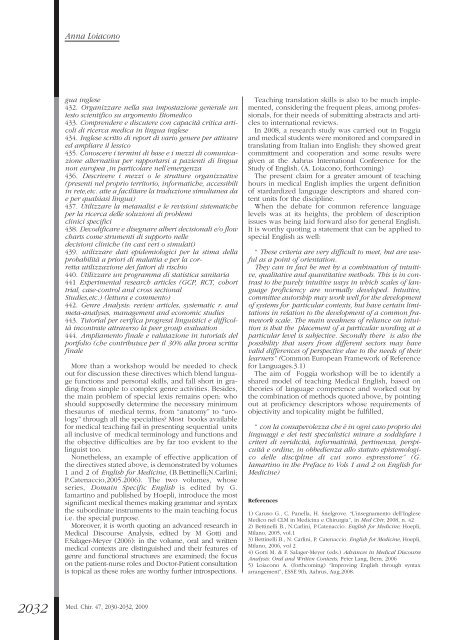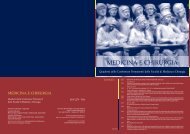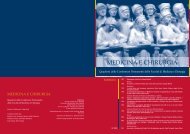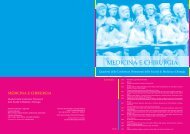You also want an ePaper? Increase the reach of your titles
YUMPU automatically turns print PDFs into web optimized ePapers that Google loves.
Anna Loiacono<br />
gua inglese<br />
432. Organizzare nella sua impostazione generale un<br />
testo scientifico su argomento Biomedico<br />
433. Comprendere e discutere con capacità critica articoli<br />
di ricerca medica in lingua inglese<br />
434. Inglese scritto di report di vario genere per attivare<br />
ed ampliare il lessico<br />
435. Conoscere i termini di base e i mezzi di comunicazione<br />
alternativa per rapportarsi a pazienti di lingua<br />
non europea ,in particolare nell’emergenza<br />
436. Descrivere i mezzi o le strutture organizzative<br />
(presenti nel proprio territorio, informatiche, accessibili<br />
in rete,etc. atte a facilitare la traduzione simultanea da<br />
e per qualsiasi lingua)<br />
437. Utilizzare la metanalisi e le revisioni sistematiche<br />
per la ricerca delle soluzioni di problemi<br />
clinici specifici<br />
438. Decodificare e disegnare alberi decisionali e/o flow<br />
charts come strumenti di supporto nelle<br />
decisioni cliniche (in casi veri o simulati)<br />
439. utilizzare dati epidemiologici per la stima della<br />
probabilità a priori di malattia e per la corretta<br />
utilizzazione dei fattori di rischio<br />
440. Utilizzare un programma di statistica sanitaria<br />
441 Experimental research articles (GCP, RCT, cohort<br />
trial, case-control and cross sectional<br />
Studies,etc.) (lettura e commento)<br />
442. Genre Analysis: review articles, systematic r. and<br />
meta-analyses, management and economic studies<br />
443. Tutorial per verifica progressi linguistici e difficoltà<br />
incontrate attraverso la peer group evaluation<br />
444. Ampliamento finale e valutazione in tutorials del<br />
portfolio (che contribuisce per il 30% alla prova scritta<br />
finale<br />
More than a workshop would be needed to check<br />
out for discussion these directives which blend language<br />
functions and personal skills, and fall short in grading<br />
from simple to complex genre activities. Besides,<br />
the main problem of special lexis remains open: who<br />
should supposedly determine the necessary minimum<br />
thesaurus of medical terms, from “anatomy” to “urology”<br />
through all the specialties? Most books available<br />
for medical teaching fail in presenting sequential units<br />
all inclusive of medical terminology and functions and<br />
the objective difficulties are by far too evident to the<br />
linguist too.<br />
Nonetheless, an example of effective application of<br />
the directives stated above, is demonstrated by volumes<br />
1 and 2 of English for Medicine, (B.Bettinelli;N.Carlini;<br />
P.Catenaccio,2005.2006). The two volumes, whose<br />
series, Domain Specific English is edited by G.<br />
Iamartino and published by Hoepli, introduce the most<br />
significant medical themes making grammar and syntax<br />
the subordinate instruments to the main teaching focus<br />
i.e. the special purpose.<br />
Moreover, it is worth quoting an advanced research in<br />
Medical Discourse Analysis, edited by M Gotti and<br />
F.Salager-Meyer (2006): in the volume, oral and written<br />
medical contexts are distinguished and their features of<br />
genre and functional structures are examined; the focus<br />
on the patient-nurse roles and Doctor-Patient consultation<br />
is topical as these roles are worthy further introspections.<br />
2032 Med. Chir. <strong>47</strong>, 2030-2032, 2009<br />
Teaching translation skills is also to be much implemented,<br />
considering the frequent pleas, among professionals,<br />
for their needs of submitting abstracts and articles<br />
to international reviews.<br />
In 2008, a research study was carried out in Foggia<br />
and medical students were monitored and compared in<br />
translating from Italian into English: they showed great<br />
committment and cooperation and some results were<br />
given at the Aahrus International Conference for the<br />
Study of English. (A. Loiacono, forthcoming)<br />
The present claim for a greater amount of teaching<br />
hours in medical English implies the urgent definition<br />
of stardardized language descriptors and shared content<br />
units for the discipline.<br />
When the debate for common reference language<br />
levels was at its heights, the problem of description<br />
issues was being laid forward also for general English.<br />
It is worthy quoting a statement that can be applied to<br />
special English as well:<br />
“ These criteria are very difficult to meet, but are useful<br />
as a point of orientation.<br />
They can in fact be met by a combination of intuitive,<br />
qualitative and quantitative methods. This is in contrast<br />
to the purely intuitive ways in which scales of language<br />
proficiency are normally developed. Intuitive,<br />
committee autorship may work well for the development<br />
of systems for particular contexts, but have certain limitations<br />
in relation to the development of a common framework<br />
scale. The main weakness of reliance on intuition<br />
is that the placement of a particular wording at a<br />
particular level is subjective. Secondly there is also the<br />
possibility that users from different sectors may have<br />
valid differences of perspective due to the needs of their<br />
learners” (Common European Framework of Reference<br />
for Languages.3.1)<br />
The aim of Foggia workshop will be to identify a<br />
shared model of teaching Medical English, based on<br />
theories of language competence and worked out by<br />
the combination of methods quoted above, by pointing<br />
out at proficiency descriptors whose requirements of<br />
objectivity and topicality might be fulfilled,<br />
“ con la consapevolezza che è in ogni caso proprio dei<br />
linguaggi e dei testi specialistici mirare a soddisfare i<br />
criteri di veridicità, informatività, pertinenza, perspicuità<br />
e ordine, in obbedienza allo statuto epistemologico<br />
delle discipline di cui sono espressione” (G.<br />
Iamartino in the Preface to Vols 1 and 2 on English for<br />
Medicine)<br />
References<br />
1) Caruso G., C. Panella, H. Snelgrove. “L’insegnamento dell’Inglese<br />
Medico nel CLM in <strong>Medicina</strong> e <strong>Chirurgia</strong>”, in Med Chir, 2008, n. 42<br />
2) Bettinelli B., N.Carlini, P.Catenaccio. English for Medicine, Hoepli,<br />
Milano, 2005, vol.1<br />
3) Bettinelli B., N. Carlini, P. Catenaccio. English for Medicine, Hoepli,<br />
Milano, 2006, vol 2<br />
4) Gotti M. & F. Salager-Meyer (eds.) Advances in Medical Discourse<br />
Analysis: Oral and Written Contexts, Peter Lang, Bern, 2006<br />
5) Loiacono A. (forthcoming) “Improving English through syntax<br />
arrangement”, ESSE 9th, Aahrus, Aug.2008.





